- Salted Shi (Regional Chinese Snack)

- Origin & History: This traditional treat from Pingtan is not only a famed Fuzhou snack but also a staple in local cuisine. Locals indulge in this delicacy during at least five seasonal festivals each year. Sweet potatoes are steamed, mashed in a stone mortar with some sweet potato starch, then shaped by hand or rolled into wrappers. The filling is a mix of shrimp, crab meat, squid, pork, and seaweed, forming a seafood meat blend. The snack is then steamed or boiled before consumption.
- Ingredients & Preparation: Main components include sweet potato, sweet potato starch, shrimp, crab meat, squid, pork, and seaweed. The preparation process involves steaming sweet potatoes, mashing them into a paste, preparing the filling, and then forming the mixture into ball shapes before steaming or boiling.
- Taste & Characteristics: The outer layer of Salted Shi is sticky, while the inside is savory and aromatic. Its taste is soft and unique to the region.
- Region & Culture: Originating from Pingtan, it’s a traditional dish in Fuzhou and has been ranked among the top ten famous regional snacks in Fujian and among Fujian’s top ten renowned snacks.
- Health & Nutrition: While rich in proteins and trace elements, its fried nature and high starch content suggest moderate consumption.
- Rou Yan (Gold Medal Chinese Tourist Snack)
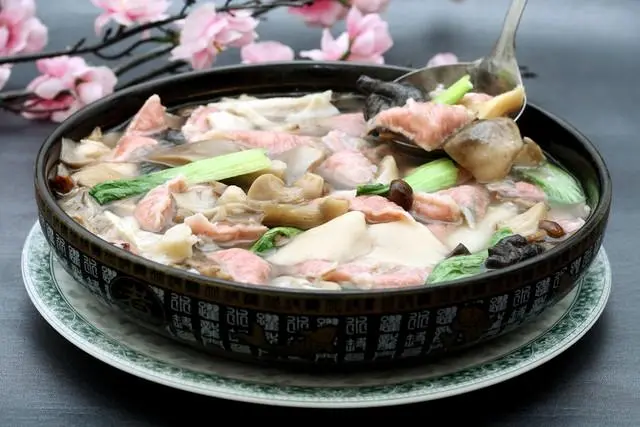
- Origin & History: Rou Yan is a renowned Fuzhou delicacy, enjoyed during festive occasions, weddings, funerals, and gatherings. The wrapper is crafted from lean meat combined with starch, symbolizing peace and prosperity and hence called “Taiping Yan” or “Peace Swallow”.
- Ingredients & Preparation: The primary ingredients include lean meat and starch. The process involves making the wrapper, preparing the filling, wrapping it, and boiling to perfection.
- Taste & Characteristics: The pastry is paper-thin, tender yet resilient, with a delicious filling and a mild taste.
- Region & Culture: Rou Yan is a traditional Fuzhou snack and has been honored as one of Fujian’s top ten snacks and a gold medal Chinese tourist delicacy.
- Health & Nutrition: Given its preparation from lean meat and starch, it’s calorie-dense and should be consumed in moderation.
- Tai Chi Taro Paste (Gold Medal Chinese Tourist Snack)

- Origin & History: A renowned traditional delicacy from Fuzhou, made using locally abundant areca taro, sweetened and steamed with lard.
- Ingredients & Preparation: The main ingredients are areca taro, sugar, and lard. Taro is steamed, mashed, mixed with sugar and lard, then reshaped and re-steamed.
- Taste & Characteristics: The dessert is velvety and moderately sweet, with a rich fragrance and displays the Tai Chi pattern, demonstrating significant artistic value.
- Region & Culture: Originating from Fuzhou, it’s a local traditional delicacy and has received the Gold Medal Chinese Tourist Snack award.
- Health & Nutrition: Packed with starch, dietary fiber, and vitamins, this snack is beneficial in moderation. However, due to the sugar and fats involved, controlled consumption is advised.
- Fuzhou Fish Ball
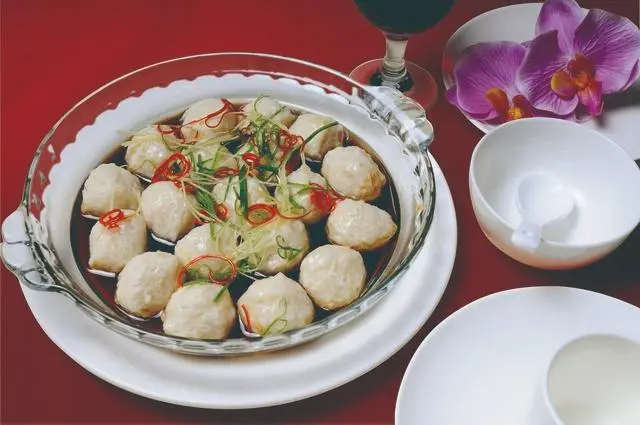
- Origin & History: A traditional specialty from Fuzhou, these balls are made from eel, shark, or freshwater fish, mashed and mixed with potato starch for the outer layer, and then filled with lean pork or shrimp. The saying goes, “A feast in Fuzhou isn’t complete without fish balls.”
- Ingredients & Preparation: Ingredients include eel, shark, or freshwater fish, potato starch, lean pork, or shrimp. The preparation involves blending, mixing, filling, and shaping into balls.
- Taste & Characteristics: These fish balls have a thin, translucent skin, shiny appearance, and are smooth, crunchy, with a rich and savory broth.
- Region & Culture: It’s a Fuzhou traditional snack, adored by locals.
- Health & Nutrition: Rich in proteins, vitamins, and minerals, but due to its starch and fat content, moderation is recommended.
- Fuzhou Thread Noodles
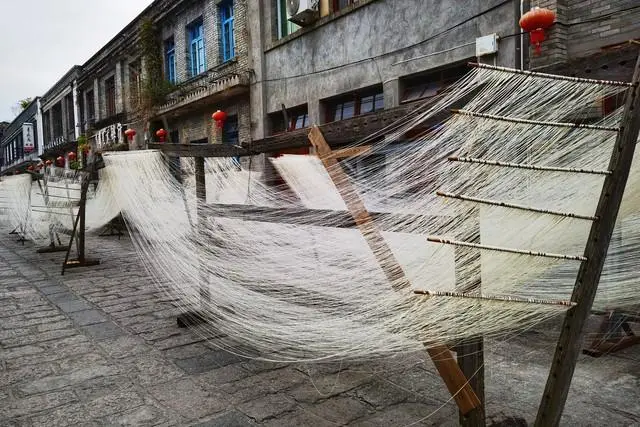
- Origin & History: Dating back to the Tang Dynasty, these noodles are famed for being as fine as hair, soft, yet resilient, and not getting mushy in soups. Locals often have them with two duck eggs for birthdays, symbolizing peace and longevity.
- Ingredients & Preparation: Made from refined flour, salt, ru powder, and edible oil, these noodles are hand-pulled and dried.
- Taste & Characteristics: They’re incredibly thin, resilient, non-sticky, and delicious when soaked in rich broth.
- Region & Culture: This traditional Fuzhou snack belongs to the Min cuisine and is cherished by locals.
- Health & Nutrition: Being high in carbohydrates and proteins, they’re somewhat calorie-dense but generally healthy as they contain no additives.
- Dingbian Hu
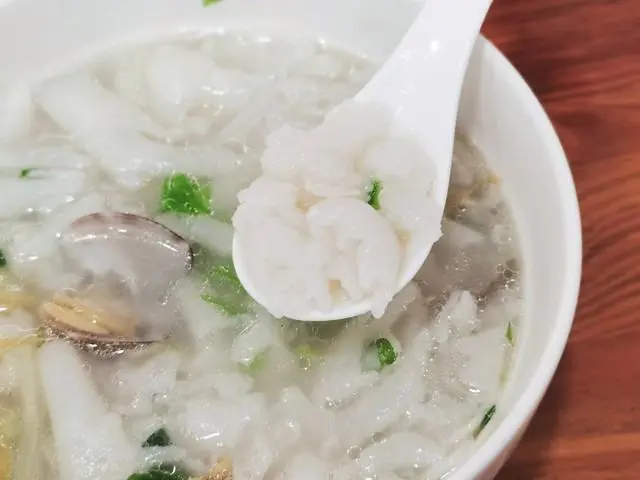
- Origin & History: This famous Fuzhou breakfast treat was an invention by the locals. Legend says it originated during the Qing Dynasty. To address life’s challenges, leftover rice batter was boiled, enriched with vegetables and seafood, giving birth to Dingbian Hu.
- Ingredients & Preparation: Key ingredients include rice batter, clams, mushrooms, dried shrimp, green onions, and daylilies. These ingredients are boiled into a clear soup, heated, and combined with the rice batter to create a layered texture, then further cooked for a short while.
- Taste & Characteristics: Its soft texture, combined with a fresh and savory soup, offers a unique dining experience.
- Region & Culture: A signature breakfast item in Fuzhou, it’s an integral part of the city’s rich breakfast culture.
- Health & Nutrition: Rich in proteins, vitamins, and minerals, it’s relatively healthy but should be consumed in moderation due to its starch content.
- Fuzhou Meat Floss
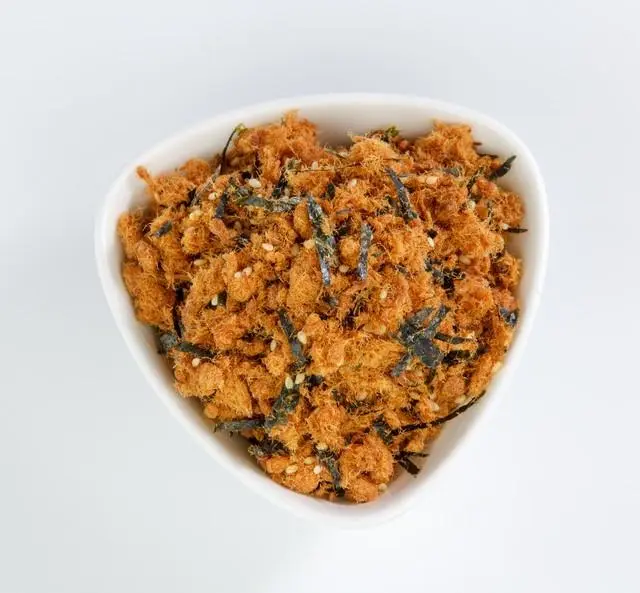
- Origin & History: A Fuzhou traditional accompaniment, it was created by Lin Dingding in 1856.
- Ingredients & Preparation: Made from lean pork, red koji, sugar, soy sauce, and cooked oil, the meat is processed into a fibrous texture.
- Taste & Characteristics: This treat is crumbly, sweet, oily but not greasy, delicious, and melts in the mouth.
- Region & Culture: A renowned Fuzhou treat, it’s a popular gift for friends and family.
- Health & Nutrition: Due to its preparation method, which involves a lot of oil and sugar, it’s not the most nutritious snack and should be consumed in moderation.
- Guang Bing

- Origin & History: Legend has it that during the middle to late Ming Dynasty, the locals created round cakes baked over fire, sprinkled with sesame seeds, to honor General Qi Jiguang’s troops. The smaller salty ones were named after Qi Jiguang, while the larger sweet ones symbolized the campaign against the Wokou pirates.
- Ingredients & Preparation: Made from flour, sesame seeds, sugar, and oil, the dough is mixed, shaped, sprinkled with sesame seeds, and pan-fried until golden brown.
- Taste & Characteristics: It’s crisp, sweet, and delicious, with a rich sesame aroma.
- Region & Culture: This traditional Fuzhou snack is also a popular gift item in the region.
- Health & Nutrition: Although delicious, its high oil and sugar content suggest moderation.
- Thousand-Layer Cake
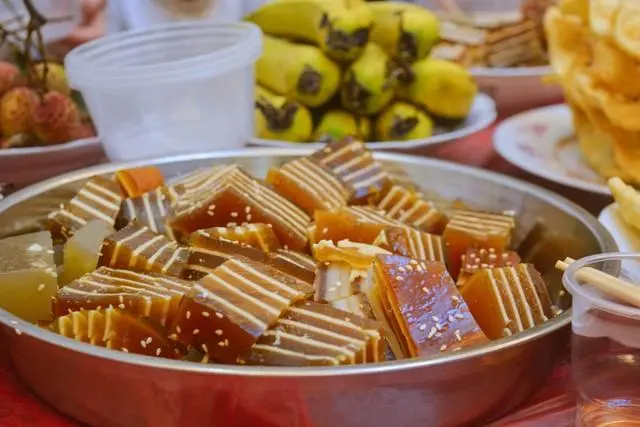
- Origin & History: This unique Fuzhou dessert, believed to have originated during the Qing Dynasty, was created by a local pastry chef named Wu using radishes native to the region.
- Ingredients & Preparation: Key components are radish, flour, sugar, and oil. The radish is diced, mixed with flour, sugar, and oil, then shaped, filled, folded, and pan-fried until golden.
- Taste & Characteristics: Thin layers filled with plenty, its taste is refreshingly sweet, and the texture is both crisp and soft.
- Region & Culture: It’s a traditional delicacy in Fuzhou and often featured in celebratory banquets.
- Health & Nutrition: Rich in proteins, carbohydrates, and vitamins, however, due to its oil and sugar content, it’s advised to eat in moderation.
- Turnip Cake
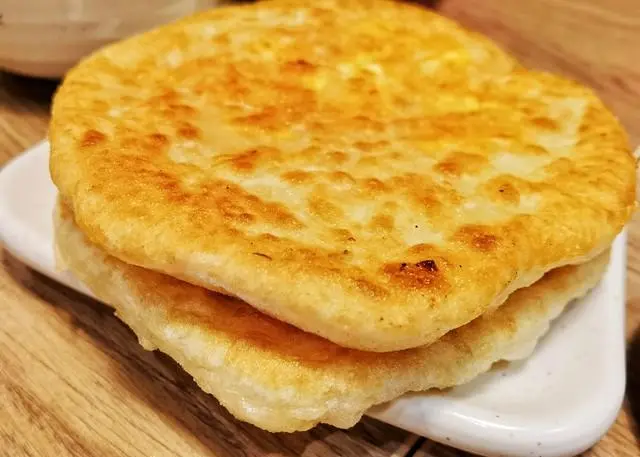
- Origin & History: A traditional Fuzhou pastry said to have originated during the Qing Dynasty. A pastry chef surnamed Wu used local turnips to create this delectable snack, which quickly became a local favorite.
- Ingredients & Preparation: Made from turnips, flour, sugar, and oil, the turnip is cut into small dices, mixed with flour, sugar, and oil, then shaped into balls, flattened, filled, and pan-fried until golden.
- Taste & Characteristics: The outer crust is crisp, while the inner filling is soft and fluffy, offering a unique taste.
- Region & Culture: It’s one of the renowned snacks in Fuzhou and is often served during festive banquets.
- Health & Nutrition: Though packed with proteins, carbs, and vitamins, due to its oil and sugar content, it’s advised to eat in moderation.